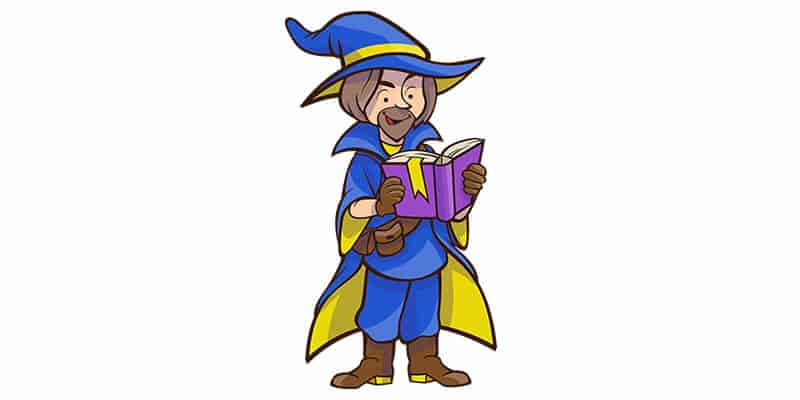Wizards in Dungeons and Dragons 5e who follow the School of Illusion have a knack for confusing enemies and manipulating NPCs. This character is great for those who want to play a mischievous, yet intelligent, party member with plenty of tricks up their sleeve. For this character, we’ll mix in elements of adventure, illusions and spells for monster encounters. Then, we’ll add odd personality quirks for the ultimate illusionist trickster.
When building a School of Illusion wizard in DnD 5e, consider the following:
- Choose forest gnome, fairy or Yuan-ti Pureblood
- Play a cunning trickster
- School of Illusion abilities
- Spell selection: minor illusion, silent image…
Before we jump in, consider playing your illusion wizard in my original pirate adventure, Dead Man’s Tale. More info here or below.
Choose forest gnome, fairy or Yuan-ti Pureblood
To begin, let’s pick a race that fits a wizard illusionist trope.
Forest Gnomes gain an inherent +2 Intelligence/ +1 Dexterity bonus, making them prime for wizard spellcasting. Plus, these little guys come complete with minor illusion, so we can increase our spell list from the beginning. Gnomes have a trickster reputation as it is, and forest gnomes can use woodland pets like squirrels and raccoons to complement this innate stealth and wizardry.
Fairies also carry the Fae element of tricky magic—they’ve been manipulating humans for centuries. We can choose to increase our starting character’s Intelligence by 2 and probably Dexterity by 1. Also, fairies can fly and learn inherent spells such as druidcraft, faerie fire, and enlarge/reduce spells.
Finally, I would consider the snake-like Yuan -ti Pureblood for their Intelligence (+1) and Charisma (+2). The hypnotizing snake motif works fantastically here. Plus, the character’s increased Charisma can be effective with Persuasion, Deception and Intimidation. To start, they have magic resistance, poison immunity and darkvision. On top of all this, they come with inherent spells poison spray, animal friendship (only snakes) and suggestion.
Play a cunning trickster
Wizards typically fill the role of smartest in the group. If the party needs an Investigation, Religion, History, Nature, Medicine or Arcana check, the wizard is going to be the go-to character. However, this much intelligence can sometimes drive individuals to oddball personality traits.
Illusionists have a need to manipulate, for one reason or another. Sometimes, this manipulation is harmless and fun, or maybe even for self-defense. Other times, this magic is toxic, confusing and cutthroat.
For instance, we could play a cunning forest gnome wizard who doesn’t like to resort to violent magic to achieve their goals. On the other hand, we could play a nefarious Yuan-ti Pureblood who is on a mission to reclaim her snake throne. Either way, the illusion magic will offer a whole range of creative opportunities during the game.
School of Illusion abilities
First, let’s dive into some basic abilities that every wizard learns.
- Spellbook: Wizards learn tons of spells that are recorded in their special spellbook, which the player pulls from daily. Then, the wizard can cast an amount of spells equal to his/her Intelligence modifier + Wizard level from the spellbook.
- Arcane Recovery: (Level 1) Once a day, recover a 2 pent spell slot while taking a short rest.
- Spell Mastery: (Level 18) Choose 2 spells to cast at will. One is a level-1 spell, the other is a level-2 spell.
- Signature Spell: (Level 20) Choose two level 3 spells and cast them for free. Afterwards, a short or long rest is required to cast for free again.
The Illusion Goodies
At level 2, I’ll gain my first effects from the School of Illusion, Illusion Savant and Improved Minor Illusion. Illusion Savant halves the time and gold spent to copy an illusion spell into my spellbook. However, Improved Minor Illusion gives me minor illusion if I don’t already have it. Plus, my illusion can now make a sound.
Then, level 6 grants me Malleable Illusions. Now, I can change the nature of an illusion while it is cast on the field. This can open my creativity to all kinds of situations. Perhaps I need to convince someone in a bar that a fellow patron is in fact a werewolf. I’ll simply cast a silent image spell of a man transforming. I’ll need an illusion lasting 1 minute or longer.
Level 10 gives me Illusory Self—a clever defensive measure. Whenever a creature attacks me, I can create a duplicate of myself. This duplicate causes the enemy to miss and dissipates, which comes in super handy as a squishy wizard. However, I can only use this once per short or long rest.
Finally, level 14 grants me Illusory Reality. This ability utilizes shadow magic to make my illusion spell (1st level or higher) real for up to 1 minute. I can’t use it to harm anyone—like a sword or bow. But I can use it to traverse difficult terrain. For instance, I can create illusory ropes, bridges and stairs long enough for my party to use them.
Spell selection: minor illusion, silent image…
Now, for the fun part. Spell selection is a big deal for the wizard class. I’m essentially the guy with all the magic. However, I want to pick spells at each level that complement my role in the party and express my mischievous nature. Plus, I’ll need defense, attack and adventure spells. Here’s a few ideas to get started.
Guide to Building a Bladesinger Wizard: DnD 5e
| DnD 5e Guide to Building Puzzles
|
Cantrips
My free spells need to include a solid attack mixed with adventuring must-haves.
- Minor illusion: This one is obvious. I can make a small illusory effect of sound and a small image. Of course, my school gives me the ability to do both simultaneously, so I’ll have illusory tricks on hand all the time.
- Mage Hand: I’m a believer in this practical spell, which extends an ethereal hand up to 30 feet away. With this hand, I can explore high up spaces—like shelves and rooves. Plus, I can use it to safely set off traps or manipulate dangerous objects. I can only carry up to a pound, but I can still achieve quite a bit.
- Ray of Frost: Make a freezing ray spell attack. On hit, deal 1d8 cold damage and reduce the target’s speed by 10 feet. This spell offers both damage and enemy manipulation, especially when it comes to escaping brutish opponents.
- Message: Telepathically communicate with anyone within 120 feet. Essentially, this let’s me get away with table talk, which comes up more than you think. Plus, I can talk about NPCs with an ally without them hearing and reacting.
1st-level Spells
Now, I can prepare my next level of spells with a similar strategy as my cantrips.
- Silent Image: Create a visual illusion that fits within a 15-foot cube. The illusion can move naturally. However, it dissipates if a creature touches or succeeds on an Investigation check. With my special Malleable Illusions technique, I’ll be able to change the nature of this illusion whenever I want.
- Detect Magic: I can detect magical sources of power within 30 feet. The magic gives off a faint aura, and I can tell which school of magic it comes from.
- Shield: As a reaction, spend a spell slot and gain +5 AC. Plus, damage from magic missile is negated. Obviously, this is a major deal for a squishy wizard. This is one of those go-to spells for any wizard.
- Cause Fear: On a failed Wisdom save, target becomes frightened of me. Again, this will be fun to play tricks on enemies. I can’t see a whole lot of monsters with high Wisdom scores.
2nd-level Spells
Now that I have my basics, I can really start to have fun with my higher-level spell selection.
- Alter Self: This spell changes me in 3 different ways. First, I can take an aquatic form, gaining gills to breath and a swimming speed equal to my walking speed. Then, I can change my appearance to look like anyone—height, weight, face, whatever. Finally, I can grow natural weapons like claws, dealing 1d6 slashing, bludgeoning or piercing damage. Plus, I’ll gain +1 to my attack roll and gain proficiency with the weapon.
- Invisibility: I can turn invisible for up to 1 hour. Just like that.
- Phantasmal Force: This illusion is hardcore. The target gets an opportunity to Investigate when I first cast the spell. However, if they fail, they believe the illusion deeply. If they interact with it and move through it, they still believe it’s there. It can even do 1d6 psychic damage to them on each of their turns, appearing as whatever threat I choose. Fire, acid and lava can even burn them.
- Misty Step: Teleport up to 30 feet away in a poof of fog.
To Sum it Up
Illusion spells get wild as we grow in level. This is a fantastic class for those who want to play a character outside the box. Blasting fireballs and lightning bolts are cool. However, this is a typical wizard you’ve probably considered 100 times. Not only does this character offer a “sky’s the limit” element to the illusion spells, but they also have the creative challenge spell choice.




